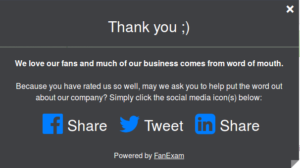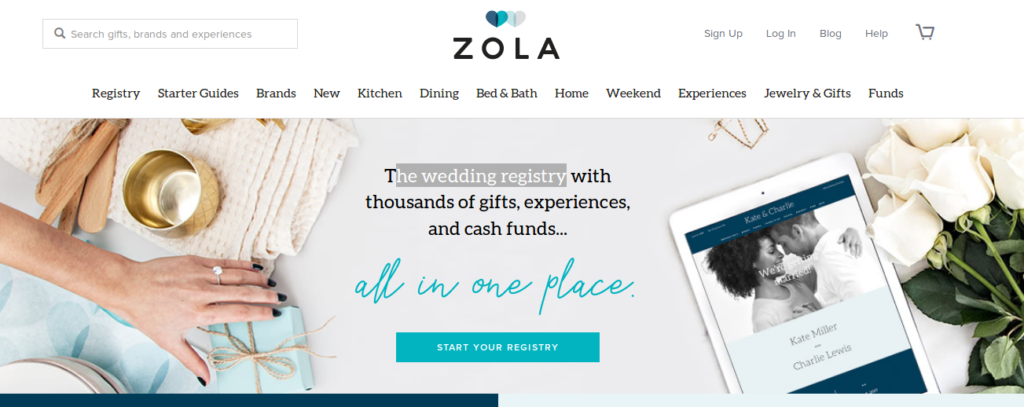Feature Update: FanExam Share Buttons
We have updated the FanExam share buttons for facebook, twitter and linkedin. One improvement is that the text color of the share links automatically adapts to your NPS text color. That means you can change the text color and background color to match the style of your own website.

How to choose a good combination of NPS text color and background color
- Make sure the color contrast between background and text is large. If the contrast is not large enough, the text will be difficult to read. This in turn would mean that a larger part of your audience would not complete the NPS survey.
- Try to match the colors in the FanExam NPS widget to the colors used in your website. You can do this by going to the FanExam dashboard and select Settings->Survey Design. When you click on preview, you can see the FanExam NPS widget. At the same time you can adjust the colors live in the widget by clicking on a color selector:

The most important part of customer feedback: how you act on it
Customer feedback is invaluable. Studies indicate that for every customer who bothers to complain, 26 other customers remain silent.1
What to do with the NPS feedback?
Once you have your NPS feedback survey up and running: what are you doing about the feedback? Just measuring your Net Promoter Score® and bringing customer feedback to the product division is not enough. You have to respond to every single customer feedback.
Detractors need the most attention ‐ and need a response ASAP.
Passives also need attention ‐ and need a response ASAP.
Promoters are the people generating your word-of-mouth marketing. You should thank them and help them.When one of your customer takes some of their valuable time to give you feedback, the least you can do is let them know that this information is valuable and thank them.
How to act when you receive a NPS response through FanExam
FanExam allows you to set up an automatic workflow whenever one of your customers answers a NPS survey. The most used automation is a simple email to a customer service person. Other possibilities include sending a Slack notification to your customer team or using Zapier for channeling the feedback into your systems.
Whatever system you use, it is important that a human answers the NPS survey. Don’t just send an automated thank you!
Customer Feedback from Detractors and Passives
When you have a Detractor giving feedback, a first step is to acknowledge the response, and then propose a solution which resolves the customers grievances. If you do this well, Detractors often will become Promoters later on.
Customer Feedback from Promoters
Promoters can be powerful allies for your product or service. These are your champions. Our recommendation is to thank for the feedback, and ask if there is something you can do to improve the customers experience. As a followup you can ask for example for a review or testimonial.
About timeliness
Studies indicate that customers believe up to 24 hours is reasonable for an email response. However, a quicker response is a good way to stand out from competition and prove to customers that you value the relationship. This is especially true for negative feedback.
Sources:
1. White House Office of Consumer AffairsHow to see where your users leave NPS feedback
FanExam measures where your users give feedback in your SaaS / website. You can see the exact page and website address where the feedback was given.
Why is this feature so important? Seeing the feedback location allows you to associate user experience and feedback rating. This feature is most important for open text feedback. Because you see exactly where the issues in your website are, and where users are happy.
How can you see the page where your users left feedback?
In your Fanexam account, go to Dashboard > Export Data and in the columns to be exported choose “URL”. Export your data, and you can see the locations where the NPS feedback was given. Once you have exported your data, you can use them in a spreadsheet like excel or Google Sheets.
Zola, NPS, and a great case study

Zola Wedding Registry When Zola started their business as an online wedding registry, their founder and CEO Shan-Lyn Ma had to confront many assumptions an unknowns. So they used two research tools to uncover what their customers really wanted:
- Interviews
- Net Promoter Score surveys
Both of these led Zola revise their offering and adapt to what their customers wanted. We learned about this NPS case study from an excellent article at firstround.com.
Like the method used in FanExam, Ma used a NPS survey on their website to question visitors and customers if they would like to recommend Zola to someone else. What is interesting about this use case is that Zola choose to focus on Detractors as a channel to hear straightforward advice. In their experience the feedback from Promoters was less clear.
Ma choose to offer the NPS survey to their customers monthly. This is more frequent than we advise per default in FanExam, but it makes sense for their specific offering (actually FanExam allows you to set the survey frequency such that it matches your specific audience preferences and your goals). As CEO Ma says: “You want to reach out when your customer is ready to give feedback and when they have a good basis for that feedback, not when it’s most convenient for you as a company.”
I can really recommend to read the whole article at firstround.com:

Firstround Zola interview Disclaimer: FanExam has no affiliation with firstround.com and Zola.
What has changed in customer feedback – Net Promoter Score?
What is happening with customer feedback?
The world of customer feedback is changing, and customer centric companies start to overwhelm their customers by asking for feedback through to many channels. There are many reasons for this, but most notable is that customers interact with their computers, laptops and phones with the same service. And each device opens a new feedback channel. Add to this email and calling, and it is easily seen how customers can feel overwhelmed. And while it might feel unfair, customers just want an easy way to give feedback. They expect that someone acts on the feedback. They expect that a person (Gasp!) comes back to them if necessary.
The old approach
The old approach is to offer as many feedback channels as possible. Have a helpdesk software. Ask customers here for feedback. Have a survey on the website. Send out emails asking for a reaction. This is to much and to disparate.
The old approach no longer works, because customers get fed up. And your company drowns in disparate feedback silos.The new approach
A new way to think about feedback: Just ask for so much feedback that your customer feels heard and that you can actually act on the feedback. If you don’t act on feedback, customers will feel that their effort is wasted. And that is true.
FanExam is working on their next generation NPS platform. We make this vision a reality.